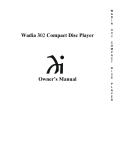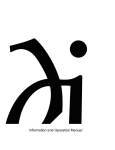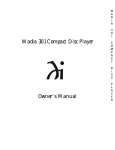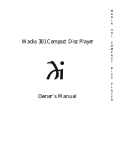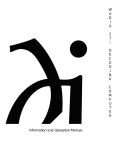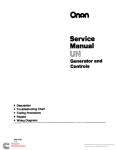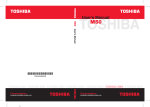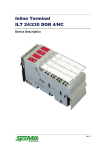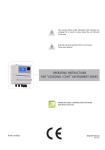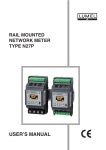Download Wadia 830 Specifications
Transcript
W
A
D
I
A
8
3
0
C
0
M
P
A
C
T
D
I
S
C
P
L
A
Y
E
R
W
A
D
I
A
8
3
0
C
0
M
P
A
C
T
D
I
S
C
All of us at Wadia would like to offer thanks and congratulations
to you for purchasing the Wadia 830 Compact Disc Player.
We sincerely believe that your Wadia 830 is an intelligent
purchase decision that will bring you many years
of musical pleasure and satisfaction.
While every new owner is anxious to begin listening,
we encourage you to take a few minutes to read this manual
and familiarize yourself with the full capabilities of the
Wadia 830 Compact Disc Player.
v
If you are in a hurry to listen, please read the sections of this
manual where the symbol at left is shown.
P
L
A
Y
E
R
I I I ,,,’‘*,So,‘:J’Y,i-,,
f ,,.--qo
Connecting Directly to an Amplifier
Connecting to a Preamplifier
Optimizing the Analog Output Level
Frequently Asked Questions
Should I use Balanced or Unbalanced connection?
Why Should I bypass the Preamplifier?
Does the Wadia Digital Volume Control compromise resolution?
Can I bypass the Wadia Digital Volume Control?
What about Analog Sources?
Should I leave the Wadia 830 with the power on?
-~ s,~ f: _, /, ., ,”
(8 I:
d,(% 1 _. y;{r:;u-a.-._ $@h. ‘,s. f, ,‘:,;I,~~~~“_=-.
, ;‘, f/1.( ”
;::.p-._~~~&f_~.. )(: .T‘ _i-: .J i ,’ (, ~qg,,~$,‘-; L
-il,((1,11p, 1
,:>y-(,LL-::
!I,!,‘( ;, ‘11;It;,‘,!, ,Tl ,’ ‘, ,d;:
‘,
_ =;+ _,,‘I. : .s.;;;:.’ ;rpJ&;,
_. /
Digital Inputs
Digital Outputs
Choosing a Digital Cable
Connecting Sources to the Digital Inputs or Outputs
PHAST Component Interface Controller Card
,;,‘,.- ‘. /I’,
:‘:1,:,!,,;_ ,) ” :, ,”0 (“,:,;Ai
,( ;, ,,“‘;‘I:‘,,,,, f,‘1, ,,‘S‘, ’
.:a),$ il. ,( , , ,
‘I ,( (‘,E
‘$$l ,I
,r,‘:
‘,
-*,t,**;_
; . it,.,,;, ./_,
‘(3 :,, “4,;,‘l!j;jr ,; ‘, -, ; ((,I,,
;
Front Panel Controls and Display
Remote Control
Remote Control Functions
-_. : ~.a~&,; :___
/ .‘;. 2$“> 1 ::r;op_ .“‘Eb----.
;;& g:
: t\>t“:_
“,<“* /,8 ,_Js:
-,;,
( Tg,,‘!; : ‘) :)(, 9,“,) ” ,.>J ;, u”ypss‘, ,((“’
1:
I!
Troubleshooting
Software License Agreement
Environmental Care
Important Safety Precautions
Specifications
Warranty
0
@
i,, *:II i‘>&,,
‘!,! ‘r*
“$c
I-:7~~~#~,_,i>,’>>,J: ~,_~~-1. ., -,‘I !!l*;T$,::,f,icr=-s. jl;-:.-_I,a:,,;$ .&_,,‘
.\, ..~~y,li,~,:;”
‘=.l_rd_a,, ,.,.:I, , ,;p&p
-!$v&j,:‘, I I; , . :, b”’-..(,W.$p
._ ’ ;;i..‘,‘. =,‘i&,,‘!
-*;i
@
DIGITAL
Wadia Digital Corporation was founded in 1988, making it one of the oldest digital audio
companies in existence. Wadia was formed by a group of engineers from the Minneapolisbased 3M Corporation (Minnesota Mining and Manufacturing) who had compiled many
years of experience in advanced digital and telecommunications research and development.
In the early 1980’s, this group had become intrigued by the emerging CD technology.
Disappointed by the sound of early CD players, they examined the designs and found them
to be unsophisticated compared with the technology available in other areas of digital design.
In response, they founded Wadia Digital - a company based on the philosophy of applying
advanced technology to improve the performance of digital home entertainment equipment.
Wadia’s first product, the Wadia 2000 Decoding Computer, was a breakthrough.
For many listeners, it proved the viability of Compact Disc as a musically involving format.
Ever since, Wadia has continued to develop on the original technology - refining, listening
and improving along the way. Since the Wadia 2000, new generations of even higher
performance designs have been introduced. Each step of the way, Wadia has raised
the standard for performance of CD playback.
Here is an abbreviated list of the technological innovations the Wadia engineers
have pioneered over the past 10 years:
l
First outboard Digital-to-Analog converter
l
DigiMaster patented algorithm (filter optimized for reproducing music)
l
First company to apply glass fiber-optics to home audio
l
First company to recognize jitter as a source of audible distortion
l
First to perfect digital volume control
l
First high-end CD player competitive with expensive separates
l
Clocklink proprietary jitter reduction technology
Although Wadia’s digital expertise and track record exceed those of any audio company,
technology alone does not guarantee musical performance. Wadia designs are born of a
delicate balance of technology shaped by a passion for music.
Now past our tenth year, Wadia continues to redefine the limits of digital music playback.
We are proud to introduce the Wadia 830 - a breakthrough in sonic performance
and a strong statement of our years of dedication to music.
After carefully unpacking your Wadia 830 Compact Disc Player, inspect it for any shipping
damage and call your dealer immediately if any is found.
B
Da not plug your Wadia 830 Compact Disc Player into any out/et if you find shipping damage.
Please save all packing materials so the unit can be easily and safely shipped if the need arises.
Included in the carton, you will find an accessory kit that contains the following:
l
AC power cord
l
Remote Control
l
Two type-AAA batteries
The Wadia 830 remote control requires two batteries, which you will find in the accessory kit.
To install the batteries, gently pry open the battery cover on the back of the remote. Insert the
batteries as indicated on the battery holders, and replace the cover.
I
Q
CHECK
VOLTAGE
HERE!
Check to make sure your Wadia 830 Compact Disc Player has been manufactured for
operation at your AC line voltage. Attempting to use your Wadia 830 Compact Disc Player
at any voltage other than specified on the rear of the unit may cause damage which is not
covered by Wadia’s warranty If the voltage specified is different from your AC voltage,
contact your Wadia dealer.
USING AC LINE CONDITIONERS
In most cases, best performance is obtained when the Wadia 830 is plugged directly into the wall
outlet using the AC power cord provided. The Wadia 830 employs extensive power-line filtering
and noise suppression technology. It should not be necessary to use power conditioners or aftermarket power cords. If you wish to experiment with any of these devices, work closely with your
dealer and most of all, trust your own ears.
USING A “SURGE PROTECTOR”
Although the Wadia 830 will resist significant voltage spikes, it can still be damaged by extreme
voltage overload such as a lightening strike. Such damage is not covered by the warranty.
In some circumstances, a “surge protector” can help prevent this type of damage. However,
surge protectors often degrade sound quality. Each Wadia owner must weigh the protection
offered by a surge protector against the sonic degradation.
Avoid allowing static shocks to be applied to the inputs or outputs. To prevent static shocks,
touch any grounded surface, such as the Wadia 830 chassis, before connecting or removing
a cable. It is unlike/y that a static shock will damage the unit, but it may cause the Wadia 830
Compact Disc Player circuifry to “lock-up” (see lock-Up under Trouble Shooting in Appendices)
lnputs and otputs can be safely connected to the Wadia 830 Compact Disc Player:
1. When the AC power is switched off
-OR2. When the unit is in Relay-Mute mode (See Mute in Operation)
We strongly recommend that you connect your Wadia 830 Compact Disc Player directly to
your power amplifier. Even if you purchased your Wadia 830 with the intention of connecting it
through a preamplifier, we suggest that you experiment with direct connection to your amplifier.
Many listeners are surprised by the improvement in performance over even the most expensive
preamplifiers. If you would like more information about getting best performance from a system
without a preamplifier, contact your Wadia dealer.
To connect your Wadia 830 to a power amplifier, ensure that your power amplifier is turned
off, then connect your analog interconnects from the Wadia 830 balanced or unbalanced
analog outputs to the amplifier’s inputs.
While the Wadia 830 Compact Disc Player was designed to be used without a preamplifier,
it will provide excellent operation in a conventional system with a preamplifier. Simply connect
the analog outputs from the Wadia 830 to a pair of line-level inputs on the preamplifier.
When using a preamplifier, bypass the Wadia 830 volume control by setting it to its maximum
volume. When set to the maximum volume level, only the top LED will be illuminated. In this
setting, the volume control is completely bypassed.
Best performance is obtained when the Wadia Digital Volume Control is operated in the top
one-third of its range. If you find that your critical listening occurs with the volume indicator
showing fewer than seven LED’s, then it may be advantageous to attenuate the output. This is
done by manipulating a set of internal switches. If you would like to change the output level,
consult your dealer.
The Wadia 830 output level is factory set at 4.2 volts which will accommodate the most
common range of system sensitivity without needing adiustment.
SHOULD I USE A BALANCED OR UNBALANCED CONNECTION?
We recommend using the balanced analog output from your Wadia 830 Compact Disc Player connected
to a true balanced input. All things being equal, properly implemented balanced (also called differential)
circuitry sounds better than unbalanced circuitry. The Wadia 830 is a true balanced design. It generates
the inverted signal in the digital domain and all subsequent processing is done in balanced mode.
Your Wadia 830 is designed to maintain many of the advantages of true balanced design when using the
unbalanced outputs. In addition, the Wadia 830 output stage is capable of driving both types of outputs
simultaneously.
The balanced outputs use the standard audio pin configuration: pin 1 is ground, pin 2 is positive, and
pin 3 is negative.
WHY SHOULD I BYPASS THE PREAMPLIFIER?
A preamplifier is unnecessary when using your Wadia 830 Compact Disc Player. The Wadia Direct
Connect technology incorporated into the Wadia 830 provides all the necessary control functions of a
preamp while the signal is still in the digital domain. This avoids the sonic degradation caused by analog
circuitry, switches, and wire. The Wadia Direct-Connect output stage can drive any power amplifier and
any interconnects, even very long lengths.
DOES THE WADIA DIGITAL VOLUME CONTROL COMPROMISE RESOLUTION?
The Wadia 830 Compact Disc Player uses the latest generation of Wadia’s proprietary Digital Volume
Control. The volume level is adjusted in the digital domain by means of mathematical manipulation of the
signal, eliminating the distortion and noise that are inevitable with even the best analog volume controls.
While conventional thinking indicates that reducing the volume digitally can sacrifice low-level resolution,
Wadia has created an innovative solution. Wadia’s patented DigiMaster digital filtering algorithm produces a 24-bit output rather than the 16 bits stored on the CD. This high-resolution signal is then used in
the computations which in turn reduce the volume level. This new signal is fed directly to the DAC chips.
Through this innovative method, the Wadia 830 maintains high resolution even at the lowest volume
control settings.
CAN I BYPASS THE WADIA DIGITAL VOLUME CONTROL?
The Digital Volume Control can be bypassed by setting it to the maximum setting so that the front panel
bar-graph display shows only the top LED illuminated. The Wadia Digital Volume Control operates in
the digital domain; it is a computer program which performs calculations on the numeric values from the
CD recording. If the Digital Volume Control is set to its maximum, this computer program is bypassed.
There are no passive parts, switches contacts, resistors, or even circuit board traces associated with
the digital volume control.
WHAT ABOUT ANALOG SOURCES?
To use analog sources in an otherwise digital system, Wadia has introduced the Wadia 17
Analog-to-Digital converter. Now it is possible to use analog sources, such as a tuner, tape deck,
or even a turntable (in conjunction with a suitable phono stage) in your system without using a
conventional analog preamplifier. Consult your dealer for more information on the Wadia 17
and other future Wadia Analog-to-Digital products.
SHOULD I LEAVE THE WADIA 830 WITH THE POWER ON?
The Wadia 830 is designed to be left with the power on with no harm or wear to the unit. All motors
and laser circuitry turn off when the unit stops playing. Leaving the power on allows the circuitry to
remain at a constant operating temperature, providing better performance and longer life. Careful
listeners will notice that the sound of the Wadia 830 will improve steadily after the unit is powered-up.
A new unit will undergo more dramatic changes when power is applied for the first time. If you turn off
your Wadia 830 for more than an hour, you will find that the unit will undergo similar but less dramatic
improvement once power is reapplied. Depending on the resolution of the system and the attentiveness of
the listener, you may find that the sound continues to improve over the first several weeks of operation.
The Wadia 830 is a modular design.
It can be equipped with any combination of the following options:
l
Digital Inputs
l
Digital Outputs
l
PHAST component interface control card
The standard version of the Wadia 830 is not equipped with these options, but any of them can
be added - either at the time of purchase, or at a later date. If you are interested in adding any
of these options, consult your dealer.
Digital Inputs allow you to decode other digital sources and receive all the benefits of Wadia’s
decoding performance. The Wadia 830 Digital Input card has the following inputs:
Input 1: Glass-fiber optical
Input 2: Coaxial with BNC connector
Input 3: Coaxial with BNC connector
Input 4: Plastic-optical TOSLINK
Any of the inputs will automatically adjust to the sampling rate, 32 KHz, 44.1 KHz or 48 KHz
when connected to any standard digital audio output.
To select a different input, use the INPUT button on the remote control. The input select is a
scrolling feature. For example, while listening to CD, pressing the input select button will switch
to input 1. Pressing again will switch to input 2, and so on. After input 4, pressing again will
switch back to CD.
The Wadia 830 can be equipped with the optional digital outputs to allow the internal CD
transport to feed another component, such as a digital tape recorder. The configuration for the
digital output card is as follows:
Output 1: Glass-fiber optical
Output 2: Coaxial with BNC connector
The digital output signal is active on both outputs when a CD is playing in the transport.
For maximum performance, we recommend using an ST glassoptical cable, which can be
purchased from your Wadia dealer.
Wadia Digital was the first company to use glass fiber-optic data transmission in digital audio.
We have continually improved this format and believe that it offers the best, most consistent
performance of all the available options. Based on our experience, here is a list of digital
interface methods in descending order of performance:
1. ST-type Glass optical (as implemented by Wadia, with high quality glass-optical cable)
2. AES/EBU using XLR connector
3. Coaxial S/PDIF cable using BNC connector
4. Coaxial S/PDIF cable using RCA connector
5. TOSLINK plastic-optical cable
The quality of any of these transmission methods depends on the quality of the cable and the
sophistication of the transmitter and receiver. For example, a high-quality coaxial S/PDIF cable
can out perform a low-quality AES/EBU cable. A high-quality AES/EBU cable may outperform a
poorly-implemented glass-optical system
If you are using a coaxial S/PDIF connection we recommend having the cable terminated with a
BNC connector. This will provide higher performance than an RCA connector. Your Wadia 830
input or output kit comes with an RCA/BNC adapter that can be used for experimentation
between different types of coaxial S/PDIF cables.
Again, we highly recommend that you take advantage of your dealer’s experience and, most
importantly, trust your ears,
Using the digital cable of choice, connect the appropriate digital input or output to the
outboard component.
The Wadia 830 can be equipped with this card to allow it to interface with the PHAST
component control and home automation system. For more information on this remarkably
powerful and flexible system, contact your Wadia dealer.
v
NOTE: The disc should be placed on the loading fray with the printed label facing down.
Volume Display
Volume Up/Down
Pause Indicator
Drawer Open/Close
Repeat Disc Indicator
Repeat Track Indicator
stop
_ Phase Invert Indicator
Track Forward/Back
v
/
Pause
Repeat
Drawer Open/Close
stop
Plby
Input Indicator
\ Mute Indicator
Phase Invert
Input Select
Play
Pause
Next Track/Previous Track
Volume Up/Down
Search Back
Search Forward
PLAY: Pressing play causes the unit to begin playing. If the drawer was opened, the unit will
close the drawer, and then begin playing.
STOP: Pressing stop causes the disc to stop playing.
PAUSE: Pressing pause suspends playing until play is pressed, or until pause is pressed again
VOLUME UP and VOLUME DOWN: Pressing these increases or decreases volume by 0.5 dB. The
LED bar graph on the front panel indicates the volume level, with one light illuminating
for every 5 dB increase in volume. At the maximum volume level, only the top volume light
is illuminated.
NEXT TRACK/PREVIOUS TRACK: Pressing these keys skips to the next, or previous track.
DRAWER OPEN/CLOSE (O/C): O pens and closes the CD loading drawer.
INVERT*: The Wadia 830 has the ability to invert absolute phase in the digital domain. Pressing
the Invert key on the remote control will cause the Wadia 830 to invert phase; pressing it again
will switch the phase back to normal. When the phase is inverted, the PHASE LED will illuminate
on the front panel.
MUTE*: The Wadia 830 Compact Disc Player has two mute modes that are automatically
implemented under different circumstances. Note that CD will continue playing even when
the output is muted.
Software Mute: When the Mute key is pressed on the remote control, the Wadia 830
Compact Disc Player’s DSP engine transmits a stream of zero signal level samples to the DAC
section, which results in zero output.
Relay Mute: The Wadia 830 Compact Disc Player has mute relay connected between the
positive and negative outputs. When this relay is engaged, it connects the positive output to
the negative output, reducing the output to zero. This relay, which produces an audible click
when it engages or disengages, is not in the music signal path. The mute relay is engaged:
1. When the Wadia 830 Compact Disc Player detects AC input level below its minimum
operating range.
2. Each time the Wadia 830 Compact Disc Player power switch is turned on.
3. When the volume control is set to zero AND the mute key on the remote control
is pressed.
When the Wadia 830 is in either Mute Mode, the Mute LED will illuminate.
REPEAT*: Pressing this button will cause the disc to repeat continuously. Pressing it twice will
repeat the current track continuously. Pressing it a third time will stop repeating. The repeat
mode is indicated by the front panel LED’s
INPUT’: The Wadia 830 Compact Disc Player can be configured with four digital inputs,
in addition to the internal CD drive (See section on Optional Inputs). Each time the input key
is pressed, the next input is selected. For example, if you are listening to the internal CD drive,
and you press the input select, Input 1 will be selected, press it again, and Input 2 will be selected
and so on. After Input 4, the list will begin again with the CD drive.
SEARCH FORWARD/BACKWARD*: Pressing and holding these keys will speed forward or
backward within the current track.
*These functions are available on the remote control only.
LOCK-UP
If the Wadia 830 experiences a powerful static shock or sudden AC surge, it is possible to
“lock-up” the computer circuitry. A locked-up computer may result in erratic display, no output,
and no response to remote commands.
If your Wadia 830 should lock-up, unplug the AC cord. Wait at least 30 seconds before
plugging the unit in again. If the unit still does not operate normally, contact your dealer.
THIS AGREEMENT SETS FORTH TERMS AND CONDITIONS FOR THE DigiMaster SOFTWARE.
The DigiMaster software is copyrighted and patented. It is the property of Wadia Digital
Corporation of River Falls, Wisconsin.
Title to Licensed Software is not transferred to the customer. The customer is granted a
nonexclusive license to use the Licensed Software on a single CD Player basis. The Licensed
Software cannot be shared among multiple CD Players. Each CD Player must have its own
separately Licensed Software.
At Wadia Digital Corp.‘s sole discretion, Wadia Digital shall provide customer with updates of
the Licensed Software. Wadia Digital retains the right to provide the Licensed Software updates
for a fee. The customer may refuse to accept such Licensed Software updates.
Wadia Digital makes every effort to be an environmentally conservative company.
We greatly appreciate it when our customers join our efforts. Please dispose of batteries
and packing material in a manner that is environmentally responsible.
To get the best performance from your Wadia 830 CD Player, and for your own safety,
please read and follow these important safety instructions.
1.
Before operating the Wadia 830 CD Player please read all of the operating and
safety instructions.
2.
Never place the Wadia 830 CD Player near heat sources such as radiators, fireplaces,
stoves, or other appliances that produce heat. Avoid placing the Wadia 830 CD Player
where it will be subject to direct sunlight or low temperatures.
3.
This product is equipped with a three prong IEC power inlet that includes an earth ground
connection. To prevent shock hazard, all three connectors must always be used. If your
electrical outlets will not accept this type of plug, an adapter may be purchased. If an adapter
is necessary, be sure it is an approved type and that it is used properly, supplying an earth
ground. If you are not sure of the integrity of your home’s electrical system, contact a licensed
electrician for assistance.
4.
AC extension cords are not recommended for use with this product. If an extension cord
must be used, be sure it is an approved type and has sufficient current carrying capacity
to power this product.
5.
Before cleaning the Wadia 830 CD Player, always disconnect the power supply cord.
Use a soft cloth and, if necessary, dampen with clean water or mild cleaning agent.
Never apply water, or any other cleaner, directly to the chassis.
6.
If you smell smoke, or an abnormal smell, immediately unplug the Wadia 830 CD Player
from the power supply and contact your Wadia dealer.
7.
Never attempt to service the Wadia 830 CD Player beyond what is described in this
Owner’s Manual. All service should be performed by qualified service personnel.
8.
Unplug unit if it becomes wet.
9.
Do not open unit when attached to AC outlet.
10. Replace fuse only with the exact type originally included.
100 volt: 1 amp Slo-Blo (1 fuse]
120 volt: 1 amp Slo-Blo (1 fuse)
220 volt: l/2 amp Slo-Blo (2 fuses]
240 volt:
l/2
amp Slo-Blo (2 fuses)
1 1. Do not attempt to repair or modify your Wadia 830 CD Player.
Pickup Mechanism
Pioneer Stable Platter
Decoding Software
32-Times Resampling DigiMaster
Digital Processing Capability 24 Bits
Digital Volume Control Range 50 dB in one-hundred
l/2
dB steps
Digital Resolution
21 Bits
Analog Outputs
One pair of Balanced (XLR); One pair of Unbalanced (RCA).
Both can be used simultaneously.
Optional Digital Outputs
1 - Glass Fiber-Optic (ST); 1 - S/PDIF (BNC)
Optional Digital Inputs
1 - Glass Fiber-Optic (ST); 2
1 - Plastic Optical (Toslink).
Output Impedance
Less than 15 ohms
Power Consumption
18 watts
Weight
16 Ibs.; 20 Ibs. including carton
Dimensions (W x D x H)
l7~141/2x43/4inches(43x27x12cm)
- S/PDIF (BNC);
WARRANTY
This Warranty covers the Wadia 830 Compact Disc Player
Wadia Digital warrants that this product shall be free from defects in materias and workmanship for:
1 year for the player mechanism’s mechanical structure and associated electronics,
and 5 years for all other parts of the product (excluding batteries).
The warranty period begins at the date of sale and is subject to the following requirements and understandings:
1) The product must not have been modified in any manner whatsoever, or the warranty is immediately voided.
2) The product must not have been stored in a humid, damp environment; nor subjected to weather, water,
or salt spray.
3) During the warranty period Wadia Digital will repair the Wadia 830 Compact Disc Player to working
order, or, at Wadia’s option, replace a defective Wadia 830 with a similar available product, at no cost
to the owner for labor, materials, and shipping charges from Wadia Digital, River Falls, Wisconsin.
4) Wadia Digital shall not, under any circumstances, be liable for any incidental or consequential damages
arising from the loss of property or other dama.ge or losses due to the failure of a Wadia 830 Cornpact
Disc Player. Wadia Digital will not pay for loss o use or inconvenience caused by the failure of a Wadia
830 Compact Disc Player. Wadia Digital will not pay for damage caused to other audio components
caused by the failure of the Wadia 830 Compact Disc Player within the limits allowed by State law.
5) All repairs performed after the warranty period has expired will be billed to the owner and will carry a
90 day warranty on parts and labor.
6) The customer is responsible for the shipping charges for all repairs, warranty or non-warranty, shipped to
Wadia Digital. Digital will pay return shipping to the customer or dealer (within the United States)
for all warranty repairs. Special shipping methods or services will not be covered by Wadia Digital.
7) All repairs must be serviced by Wadia Digital or an authorized service facility.
8) This product is only warranted in the country of original sale by Wadia Digital.















